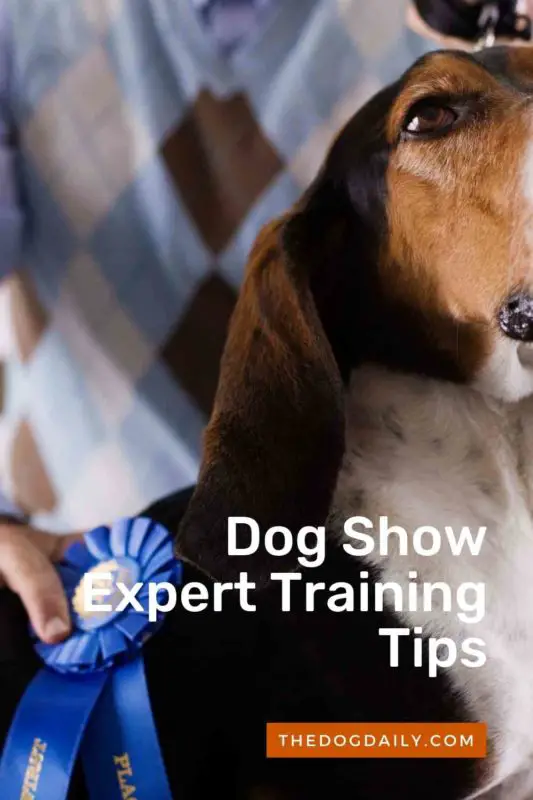Show Dog Expert Training Tips for Your Dog
Whether Champion Blackjack Porpoises’ Ship Zin UDX III is under the bright lights at a dog show or visiting sick kids in the hospital, Dr. Gail Clark knows she can count on the Portuguese Water Dog to behave well.
As the 5-year-old dog is affectionately known, Ship handles crowds, other dogs, and unfamiliar situations with ease, says Dr. Clark, Ph.D. Dr. Clark is a dog behaviorist in Fort Collins, Colo., who offers training for both household dogs and classes for potential show dogs like Ship and their owners.
“He’s fabulous,” Dr. Clark says of her dog Ship. “I bred and raised him. Without a doubt, if he hadn’t had this training, he couldn’t go into schools and hospitals. He’s just a great dog overall. He’s a pleasure to take to shows.”
No doubt, Ship behaves so well because he is showered with affection and attention, is regularly exercised, and eats a balanced, nutritious diet. The secret to the way show dogs like Ship respond to both their handlers and situations with strangers lies in their training. Although you might not need your dog to trot enthusiastically beside you under the scrutiny of a panel of judges, you can put lessons from dog show experts to work with your furry pal.
Our dog show experts say you can apply their expertise in these areas:
Socialization
Show dogs must keep their cool among hundreds of their kind, not to mention unfamiliar people. The value of early socialization can’t be overestimated, Dr. Clark says.
However, make sure your dog or puppy is in a controlled situation, say both Dr. Clark and Pat Malan, a West Virginia-based breeder of Giant Schnauzerswho also shows dogs and offers handling instruction. For instance, dog parks can be unpredictable places where your dog might be jumped and frightened by other dogs, say these experts. Be cautious even when it comes to free play during a puppy class, they caution.
A traditional obedience class is an excellent place to get your dog accustomed to other dogs and humans, says Dr. Clark. Your calm reassurance will go a long way toward helping your dog handle the unfamiliar, Malan adds. “The owner needs to be calm,” she explains. “The message you’re going to send is, ‘All is well.'”
Stacking, aka Standing Still
We’re amazed to watch dogs “stacked” at shows so that judges can evaluate the animals’ appearance and behavior. The dogs are placed in position by their handlers and then hold the positions without moving. But does this have any value when it comes to your tail-wagging buddy? Indeed, say our experts.
After all, wouldn’t it be easier to manage your dog at the veterinarian’s office or during a grooming visit if you could get your dog to stand still? Simply placing a new collar around your dog’s neck is a snap if you know dog show’s secrets.
You can practice by placing your dog on a bath mat on the counter at home if your dog’s size makes it practical, says KT McKee, a British Columbia show dog breeder and trainer. That’s great practice for the veterinarian’s exam table. Place your hand under your dog’s head to get it to stay, and don’t pet your dog. Offer a treat as your dog stays in place. Remember: Your goal isn’t to show off your dog’s perfect position, but to instead have it remain cooperatively still for a while.
Handling a Veterinarian Exam
It helps to think like a dog when you’re training a show dog or a household pal, say dog show trainers. Imagine how canines will perceive noises, other dogs, and crowds. But it doesn’t hurt to think like a human, either. Imagine a stranger at a party coming up to you and touching you without your invitation, says Dr. Clark. That slight moment of fear and surprise multiplies for dogs that don’t understand why they’re being handled.
When her dog shied a bit once a judge wanted to exam the pup’s private parts, Dr. Clark told the judge he needed to offer her dog a kiss first. In other words, says Dr. Clark, make sure your dog is “properly introduced” to someone who wants to touch your pal. “Anytime a dog is touched without an invitation from the dog, it’s negative,” she explains.
Place your hand lightly in your dog’s collar. Let it become familiar with the person, then offer a food treat when someone touches or examines your dog. Your dog will learn to associate the touch with something positive.
Gaiting
It might be the most impressive scene at dog shows: Dog after dog runs smartly alongside the handlers. There are a couple of keys to accomplishing a modified version of this behavior with your dog, say the experts. First, Dr. Clark teaches her dogs with her hand on a lead right near their heads. “My hand is probably an inch from the neck of the dog.”
Remember the phrase “short leash?” It’s applicable here. Practice with a short lead, walking your dog back and forth in a confined area. Reward your pet every time it follows you in an appropriate, well-behaved manner. Gradually move to larger areas and allow a bit more leash. If you teach your dog these gaiting techniques, you’ll have an easier time on crowded sidewalks or other places where there’s not much room to negotiate.
Think about your collar selection, too, says McKee. Harness-type collars and collars low on a dog’s neck can trigger a pulling instinct, she says. Use a collar at the base of the head.
And give your dog a sense of purpose, McKee says. She trains her dogs by having them carry weight-appropriate backpacks weighted with a few cans and her bottle of water. “I
stop, take out my bottle of water and take a drink, then carry on, stop, take out my bottle,” she says. “The dog is providing a service.” If your dog is serving you on that walk, your dog is more likely to stay in tune with your commands.
The real trick to having your dog take its cues from show dog training comes down to you, however. “Most people don’t have the patience,” says Dr. Clark. “It takes patience, and it takes consistency.” With both, you and your dog will be strutting away proudly just as Ship the champion Portuguese Water Dog does when he’s in and out of the spotlight.
Article written by Author: Kim Boatman

